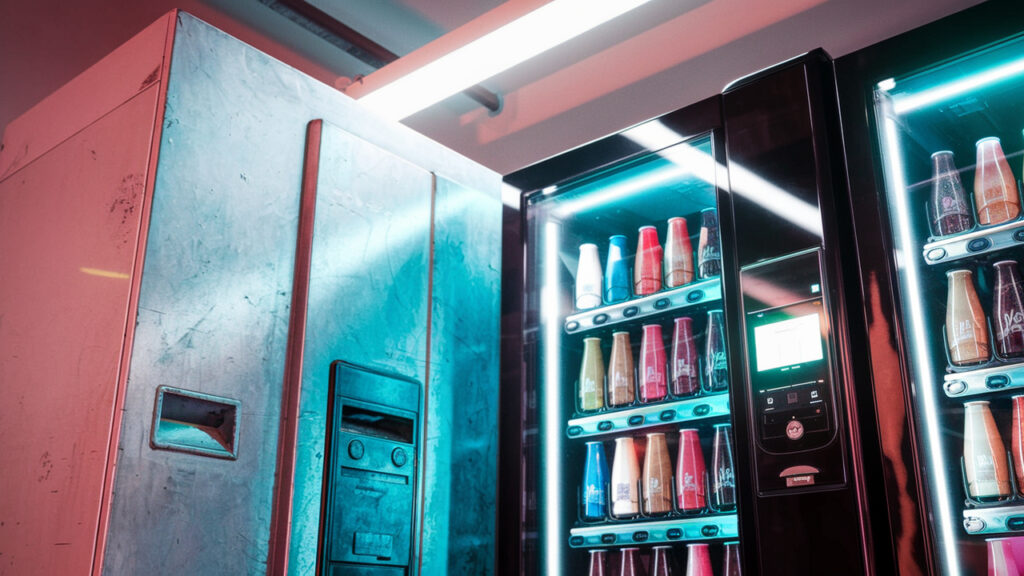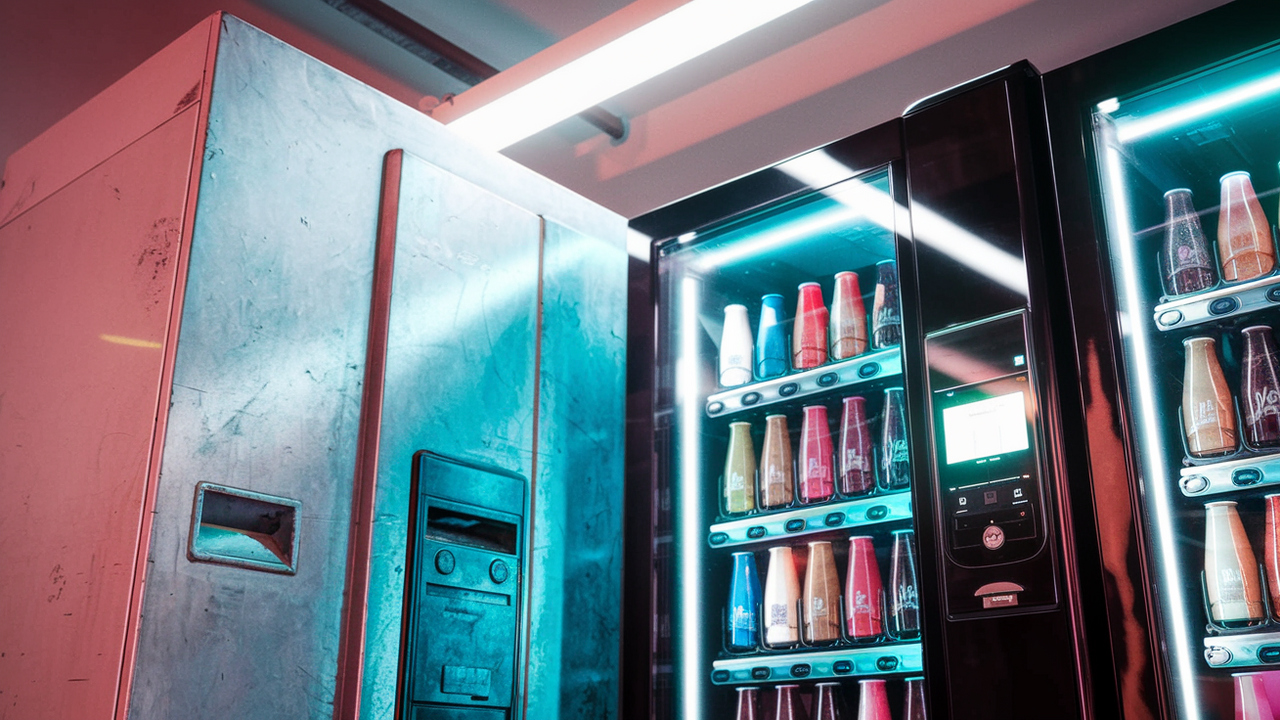Coin-Operated vs Card-Enabled Vending Machines: Which Is Better?
If you’re getting into the vending machine business in 2025, one of the first questions you’ll face is:
Should I buy a coin-operated vending machine or one with a card reader (or both)?
Each has pros and cons, and your decision can directly impact sales, customer satisfaction, and how much time you spend managing your machines. Let’s break it down so you can make the smartest choice for your location and business goals.

Table of Contents
1. Coin-Operated Vending Machines: Classic and Reliable
Pros:
- Lower upfront cost – Machines without card readers are typically cheaper.
- Simplicity – No Wi-Fi, software, or digital setup required.
- Cash in hand – You collect actual money, no waiting for digital payouts.
- Good for rural or older communities – Especially in places where cash is still king.
Cons:
- Limited payment options – Many people no longer carry coins.
- Slower to use – Customers may fumble for change or need exact amounts.
- Maintenance-heavy – Coin jams and counting coins take extra time.
- Security risks – Cash machines can attract theft or vandalism in public spaces.
2. Card-Enabled Vending Machines: Modern and Fast
Pros:
- Convenience = more sales – Customers love paying with tap, phone, or credit card.
- Works with mobile wallets – Apple Pay, Google Pay, contactless cards, etc.
- Sales tracking – You get digital reports, analytics, and inventory insights.
- Remote management – Change prices, track stock, or lock machines from your phone.
Cons:
- Higher cost upfront – Machines with cashless readers are more expensive.
- Monthly fees – Card processors typically charge 3–6% per transaction.
- Needs internet or SIM connection – May not be ideal in dead zones.
- Payout delay – You receive funds from credit sales after a few business days.
3. So… Which Is Better? It Depends on Your Location
- In city centers, offices, dorms, or airports → Card-enabled wins.
- In laundromats, low-tech areas, or old-school game rooms → Coin-operated might still thrive.
- In rural zones or high-theft areas → Coin + bill acceptor, no card reader.
- In high-traffic modern spaces → Combo (card + cash) machines are the best balance.
Think of it like this: the more modern and cashless your audience, the more likely a card-enabled machine will boost your profits.
4. Can You Have Both? Yes – and You Probably Should
Many of the best vending machines in 2025 now support hybrid payment options, meaning they take:
- Coins
- Bills
- Credit/debit cards
- Mobile pay
- NFC/contactless
This ensures you capture every sale possible. If you’re just starting out and buying one machine, a hybrid unit is often worth the investment.
5.Match Payment Options to Your Customers
Choosing between a coin-operated and card-enabled vending machine isn’t about what you prefer—it’s about what your customers use.
Visit your target location. Observe. Ask the owner or manager:
“Do most people here still use cash or do they tap their phones to pay for everything?”
That simple question can guide your entire vending machine strategy.
Pro Tip: If you’re scaling to multiple locations, card-enabled machines with smart tracking are a must. They save time, automate your business, and help you grow without being onsite daily.
One important thing to consider with coin-operated machines is the speed of cash flow. You get your money the same day you collect it, without waiting for processing delays or credit card payout cycles. For some small business owners or side hustlers, that immediate cash can be a big advantage.
However, in 2025, more customers are leaving coins and bills behind. Most people carry phones, smartwatches, or tap-enabled credit cards, especially in urban and suburban environments. If your machine only takes coins, you may miss out on 50% (or more) of potential sales.
Another thing to remember is coin acceptors require more hands-on time. You have to empty, count, and roll coins or use a coin counter. That may not sound like much, but over time—especially if you run multiple machines—it adds up.
Card-enabled machines give you the ability to track sales data in real-time, helping you restock smarter. For example, if you know a certain snack is selling faster in one location, you can prioritize it there and test new items in slower areas.
In college dorms or busy office parks, card payments are practically expected. If a student or employee walks up to your vending machine and sees only a coin slot, they might just walk away. I’ve seen machines in good locations underperform simply because they weren’t payment-compatible with the crowd.
From a maintenance perspective, card-enabled machines are often easier to troubleshoot remotely. Some smart vending machines will send you notifications when there’s a failed transaction, jammed product, or low inventory—so you don’t find out days later.
Security is another key issue. Card machines typically carry less physical cash, making them a lower target for theft. That matters if you’re placing your machine in a semi-public or lightly supervised location like an apartment complex or school.
That said, internet connectivity is a must for card readers. If the area has poor signal or no Wi-Fi, your cashless machine could fail at the most critical moment—when someone is trying to make a purchase. Always test the connection at your planned location first.
A blended approach often works best. Many modern machines let you start with coin-only, then add a card reader later. This is great for budget-conscious operators who want flexibility to grow into cashless later, without replacing the whole machine.
Another overlooked benefit of cashless machines is pricing flexibility. You can charge $1.65 or $2.25 without worrying about coin change availability. With cash-only machines, you’re often stuck at even amounts like $1 or $2, limiting your pricing options.
Additionally, cashless vending machines offer better opportunities for loyalty programs and discounts. Some readers can be paired with loyalty cards or apps, offering free drinks after a certain number of purchases—just like a coffee shop rewards card.
Finally, if you’re building a professional vending brand, card-enabled machines present a more modern, polished image. They’re cleaner looking, faster to use, and tell people, “this is a legit business, not just a side hustle.”


One thought on “Coin-Operated vs Card-Enabled Vending Machines: Which Is Better?”